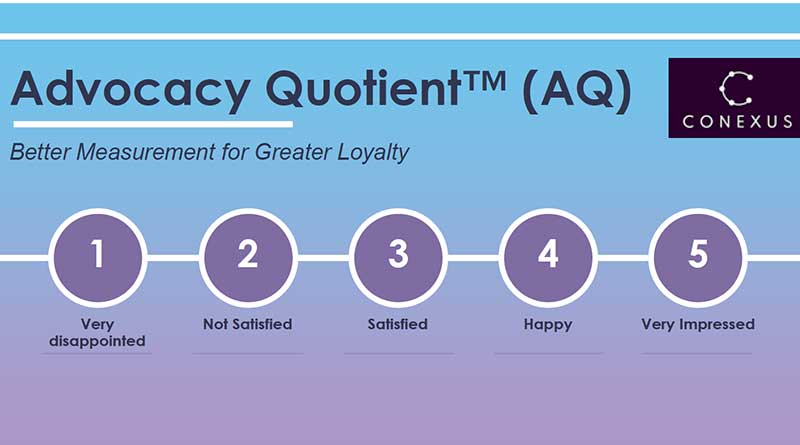How high is your AQ?
Increasing Loyalty, Referrals, and Sales
Many of you are already asking yourself, what is AQ?
AQ stands for Advocacy Quotient™. It is a scale we use to show how likely someone is to recommend our product or service to another prospect.
Now some of you may be asking, well is not that what NPS (Net Promoter Score) does?
NPS, says it measures the customer experience of your brand and provides the best metric to anchor your customer experience management program.
Fortune Magazine reports that two-thirds of the Fortune 1000 used NPS in 2020.
In our opinion, NPS has a few challenges. Full disclosure, I have friends in the space who love it, mostly because it sets a simple benchmark. Who would not love a simple tool?
NPS View
The challenges we see come from a few directions:
NPS centers around one question; “how likely would you be to recommend us to your friend or colleague?”
- While this is a solid starter, a couple of follow-up questions would make it statistically and empirically valid.
- With AQ, we use follow-up questions:
- Have you ever referred a friend to us?
- Did your referral join us?
- I have seen scholars in the Harvard Review cite NPS has a lack of depth and ask for two more questions:
- Have you recommended this brand? (Similar to above)
- Have you ever discouraged anyone from choosing this brand? (Interesting)
- In addition, NPS is one dimensional as a benchmark, without giving much in the way of actionable items to improve on your brand awareness.
Also, the scale itself can be confusing as to what score should be chosen. In conversation, I have said NPS is a 10-point scale and I get chastised by proponents that it is an 11-point scale, as you can score zero. True.

- The flaw in a scale like this is that it introduces a school-based bias, while others have a median bias.
- 10 equates in many minds to 100%, an A+
- While seven equates to 70% or a C. Satisfactory or a mid-point.
- On a 0-10 scale many people see a five in the middle, as average, when a five is a poor score or in school grading terms, an F or failure. At the same time others see it five as the middle ground, or satisfactory. (see below)

AQ Leads to Better Actionable Insights
NPS will likely have a place in business and customer experience analysis for the foreseeable future. And we agree with its simplicity and its ability to create a benchmark.
As our focus is on driving is in achieving advocacy and brand loyalty, we believe that an Advocacy Quotient™ Survey (AQ) will do a better job guiding your business.
AQ will sort Advocates into three (3) groups and a fourth by default.
- Advocates willing to promote your brand.
- Advocates who have referred your brand.
- Advocates who persuaded a new customer to use your brand, (the Golden Ticket)
- And by default, customers that are not willing to promote/refer your brand.
Now that we know the true loyalists to a brand (based on actual and potential action), we can guide them to be stronger with recognition and rewards programs and motivate others to become Brand Advocates (or Brand Ambassadors depending on the level of recognition you want).
Our Advocacy Quotient™ is simple and sets a benchmark as well. It just has a bit more depth.
Our AQ starts with a 5-point scale as to remove as much bias as possible. Good surveys should have a clear median.
We also add the second and third questions as “yes/no” to make things more objective and empirical.
Our surveys look like this (these can be adjusted by industry):
1. How likely are you to recommend our brand/service/product to a friend or colleague?

2. Have you been satisfied with the reservation process?

3. Have you been satisfied with the quality of the product?

4. Have you been satisfied with your experiences using the product?

5. Have you been satisfied with the timeliness of services?

6. Have you recommended us to a friend or colleague?

7. Has a friend or colleague become part of our program?

Now many NPS scores have a Voice or the Customer (VOC), like:
Can you give us a brief reason as to why you chose that score?
Added upside
While many surveys with scales merely give benchmarks, the AQ system lends itself to better modeling and subsequent actions.
For instance:
If your next step is acquiring more prospect leads, we can use the data to create a model of one the best advocates/influencers look like. From there we give them the tools they need to refer more prospects.
Additionally, we can do the same for ambassadors that referred actual purchasers and make that path easier as well.
Michael Finn, RRP, CGP, is an award-winning leader and innovator with a proven ability to develop marketing and sales potential in various markets and segments. He provides consulting services and specializes in multi-channel marketing and using brand synergy to create effective and productive programs and processes. His LinkedIn address is https://www.linkedin.com/in/michaelsfinn.


